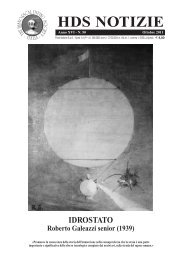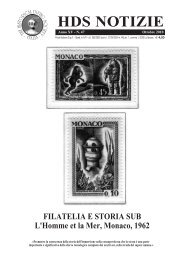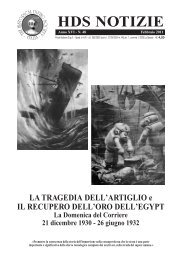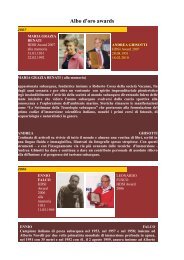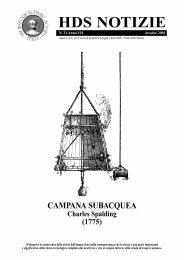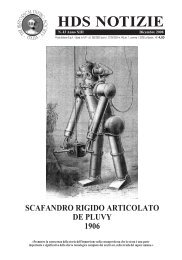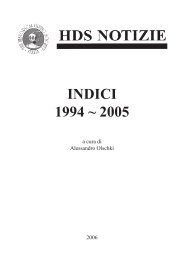hds internet - The Historical Diving Society Italia
hds internet - The Historical Diving Society Italia
hds internet - The Historical Diving Society Italia
Create successful ePaper yourself
Turn your PDF publications into a flip-book with our unique Google optimized e-Paper software.
was for recovering ‘bodies’ (lost ordnance etc.)<br />
from deep water 17) and its use by ‘any man’, hints<br />
that as it worked at atmospheric pressure it would<br />
be simpler to use than the Venetian-<strong>Italia</strong>n bell.<br />
That is, bell divers had to have had some experience<br />
of going under pressure and know how to<br />
contend with pressure on the ears and carry out a<br />
number of other difficult co-ordinated actions.<br />
Consequently they could charge a lot for their<br />
services. Bournes’ idea comes across as that,<br />
when an item of ordnance was lost overboard in a<br />
dockyard or on moorings, then ‘any man’ could<br />
use his device to recover it, quickly and cheaply.<br />
<strong>The</strong> plain breathing tube had been first described<br />
in the works of Aristotle, with narrow bore tubes<br />
added to diving helmets illustrated in any number<br />
of fifteenth century treatises and war books. This<br />
large bore design however, is usually credited to<br />
Banned Laraine, although his work Della<br />
Fortifications, which also described a square cornered<br />
heavily weighted adaption of the diving bell,<br />
was only published in Venice in 1596, eighteen<br />
years after Bourne’s description. But then Lorini<br />
included a drawing of his tube design, while<br />
Bourne’s book did not. Bournes did not even<br />
directly mention a wide bore tube in his description,<br />
only the word ‘trunk’ and that it should a spiral<br />
rope like shape, which together leave the<br />
impression that it was significantly larger than normal.<br />
At least, Bareilly (1680) later seems to have<br />
interpreted it that way (see figure 3).<br />
<strong>The</strong> spiral rope like shape is interesting as it<br />
alludes to a chimney like design, that encouraged<br />
hot air to easily rise from below. It may be significant<br />
that Cornelius Drebbel later patented a<br />
chimney design in 1602, and that there was to be<br />
much later speculation of how he managed to<br />
refresh the air in his underwater boat which was<br />
supposedly demonstrated before the king in the<br />
river Thames (1618/20). However, although<br />
Bourne must be credited with being the first we<br />
know of to think of getting rid of used air, in<br />
modern terms try to avoid the effects due to a<br />
carbon dioxide build up, he did not propose any<br />
way of providing what modern chimney terminology<br />
refers to as ‘make-up’ air, to replace it in<br />
a ‘balanced system’. On the other hand Lorini<br />
clearly illustrated two tubes, one with a large<br />
bore and one with a small bore, to supply the<br />
17) op.cit. 2<br />
HDS NOTIZIE N. 23 - Giugno 2002 - pag. 11<br />
altre corporazioni 15) .<br />
Infine, con il dispositivo numero 23, Bourne presentava<br />
un progetto completamente nuovo di<br />
attrezzatura subacquea.<br />
‘Ed inoltre fanno un rifornimento tale che chiunque<br />
può andare sul fondo dell’acqua e rimanerci<br />
a suo piacimento…’<br />
Continua dando una dettagliata descrizione scritta,<br />
ma senza disegno, di un vestito chiuso di<br />
cuoio, con maniche ed un elmo con due lenti di<br />
vetro. L’aria era fornita tramite una ‘lunga proboscide<br />
di cuoio’, in forma di cavo che tornava<br />
alla superficie dove terminava a forma di coppa,<br />
così da poter galleggiare 16) . Serviva per recuperare<br />
‘corpi’ (artiglierie perse ecc.) da acque profonde<br />
17) ed il suo uso da parte di ‘chiunque’,<br />
allude al fatto che permettendo di lavorare a<br />
pressione atmosferica, doveva essere più semplice<br />
da usare rispetto alla campana veneziana-italiana.<br />
I palombari che utilizzavano la campana<br />
dovevano aver avuto qualche esperienza riguardo<br />
la pressione e sapevano come contrastarne gli<br />
effetti sui timpani ed eseguire una serie di altre<br />
difficili azioni relative. Di conseguenza potevano<br />
farsi pagare parecchio per i loro servizi.<br />
L’idea di Bourne sostiene che, qualora un pezzo<br />
d’artiglieria fosse perso fuoribordo in un cantiere<br />
navale o all’ormeggio, ‘chiunque’ avrebbe<br />
potuto usare il suo marchingegno per recuperarlo,<br />
rapidamente ed in economia.<br />
Il semplice tubo per la respirazione era stato<br />
descritto per la prima volta nelle opere di<br />
Aristotele, con stretti tubi forati aggiunti agli<br />
elmi per immersione illustrati in diversi trattati<br />
del XV sec. e libri di guerra. Il progetto di un<br />
grande tubo comunque è solitamente attribuito a<br />
Benvenuto Lorini, sebbene la sua opera Delle<br />
fortificazioni, che descriveva anche un adattamento<br />
pesantemente zavorrato e squadrato della<br />
campana subacquea, fu pubblicato a Venezia<br />
solo nel 1596, diciotto anni dopo la descrizione<br />
di Bourne. Ma allora il Lorini includeva al pro-<br />
15) Dalla seconda metà del XVI sec. le corporazioni in<br />
Inghilterra tentarono di formare un monopolio di un particolare<br />
mestiere, o ‘mystery’ come veniva chiamato, (si veda, Joyce<br />
Brown, Guild Organisation and the Instrument-Making Trade,<br />
1550-1830: the Grocers’ and Clockmakers’ Companies, in<br />
Annals of Science, 36 (1979), p.3).<br />
16) La coppa potrebbe essere un miglioramento dell’imbuto sorretto<br />
dal sughero, illustrato da John Dee, insegnante di matematica<br />
di Bourne (1540). Vedi nota 4.<br />
17) op.cit. 2



